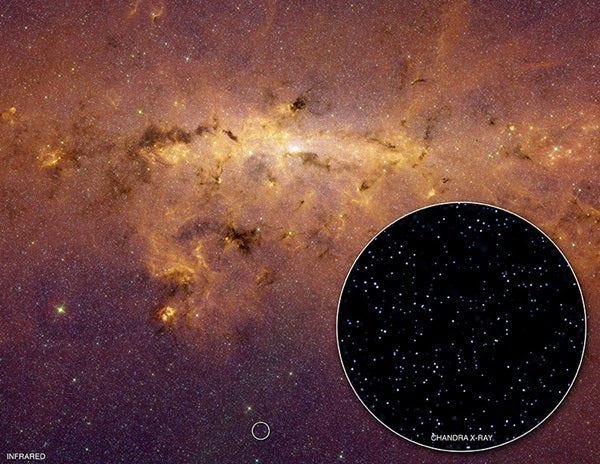An extremely deep Chandra X-ray Observatory image of a region near the center of our galaxy has resolved a long-standing mystery about an X-ray glow along the plane of the galaxy. The glow in the region covered by the Chandra image was caused by hundreds of point-like X-ray sources, implying that the glow along the plane of the galaxy is due to millions of such sources.
This image shows an infrared view from the Spitzer Space Telescope of the central region of the Milky Way, with a pullout showing a Chandra image of a region located only 1.4° away from the center of the galaxy.
The so-called galactic ridge X-ray emission was first detected more than 2 decades ago using early X-ray observatories such as HEAO-1 and Exosat. The ridge was observed to extend about 2° above and below the plane of the galaxy and about 40° along the plane of the galaxy on either side of the galactic center. It appeared to be diffuse.
One interpretation of the galactic X-ray ridge is that it is emission from 100,000,000° gas. This interpretation is problematic because the disk of the galaxy is not massive enough to confine such hot gas, which should flow away in a wind. Replenishing the gas would then be a problem, because plausible sources of energy such as supernovas are not nearly powerful enough.
A very deep Chandra observation, lasting for about 12 days, was used to study the nature of this ridge emission. The field was chosen to be close enough to the galactic plane so that the ridge emission was strong, but in a region with relatively little absorption from dust and gas to maximize the number of sources that might be detected. A total of 473 sources was detected in an area on the sky only about 3 percent of the size of the Full Moon, one of the highest densities of X-ray sources ever seen in our galaxy.
It was found that more than 80 percent of the seemingly diffuse ridge of X-ray emission was resolved into individual sources. These are believed to be mostly white dwarfs pulling matter from companion stars and double stars with strong magnetic activity that are producing X-ray outbursts or flares that are similar to, but more powerful than the flares seen on the Sun. These stars are unrelated to the large-scale structures seen towards the center of the Spitzer image, which are probably caused by young massive stars.










